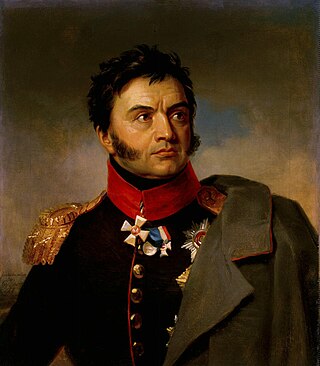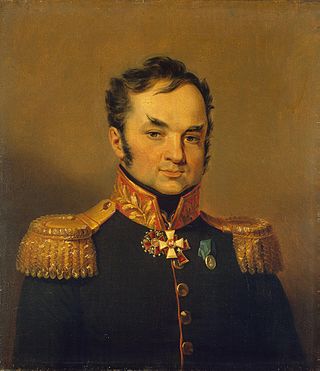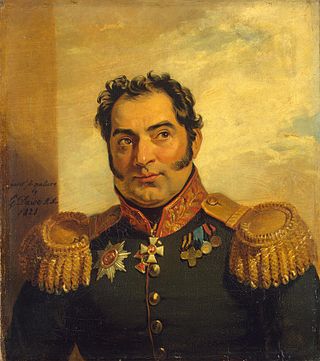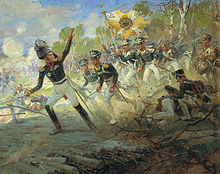
Prince Pyotr Ivanovich Bagration was a Russian general and prince of Georgian origin, prominent during the French Revolutionary and Napoleonic Wars.

The Battle of Borodino took place near the village of Borodino on 7 September [O.S. 26 August] 1812 during Napoleon's invasion of Russia. The Grande Armée won the battle against the Imperial Russian Army, but failed to gain a decisive victory and suffered tremendous losses. Napoleon fought against General Mikhail Kutuzov, whom the Emperor Alexander I of Russia had appointed to replace Barclay de Tolly on 29 August [O.S. 17 August] 1812 after the Battle of Smolensk. After the Battle of Borodino, Napoleon remained on the battlefield with his army; the Imperial Russian forces retreated in an orderly fashion southwards. Because the Imperial Russian army had severely weakened the Grande Armée, they allowed the French occupation of Moscow, using the city as bait to trap Napoleon and his men. The failure of the Grande Armée to completely destroy the Imperial Russian army, in particular Napoleon's reluctance to deploy his Imperial Guard, has been widely criticised by historians as a huge blunder, as it allowed the Imperial Russian army to continue its retreat into territory increasingly hostile to the French. Approximately a quarter of a million soldiers were involved in the battle, and it was the bloodiest single day of the Napoleonic Wars.

The Battle of Ostrovno was a military engagement that took place on 25 July 1812, between French forces under the command of King of Naples Joachim Murat and Russian forces under General Ostermann-Tolstoy and ended with the Russian forces retreating from the battlefield.

The Battle of Smolensk was the first major battle of the French invasion of Russia. It took place on 16–18 August 1812 and involved about 45,000 men of the Grande Armée under Emperor Napoleon I against about 30,000 Russian troops under General Barclay de Tolly. Napoleon occupied Smolensk by driving out Prince Pyotr Bagration's Second Army. The French artillery bombardment burned the city to the ground. Of 2,250 buildings, 84% were destroyed with only 350 surviving intact. Of the city's 15,000 inhabitants, about 1,000 were left at the end of the battle inside the smoking ruins. With over 15,000 casualties, it was one of the bloodiest battles of the invasion.

The Battle of Krasnoi unfolded from 15 to 18 November 1812 marking a critical episode in Napoleon's arduous retreat from Moscow. Over the course of six skirmishes the Russian forces under field marshal Kutuzov inflicted significant blows upon the remnants of the Grande Armée, already severely weakened by attrition warfare. These confrontations, though not escalated into full-scale battles, led to substantial losses for the French due to their depleted weapons and horses.

Nikolay Nikolayevich Raevsky was a Russian general and statesman who achieved fame for his feats of arms during the Napoleonic Wars. His family left a lasting legacy in Russian society and culture.

The Battle of Vyazma, occurred at the beginning of Napoleon's retreat from Moscow. In this encounter a Russian force commanded by General Miloradovich inflicted heavy losses on the rear guard of the Grande Armée. Although the French thwarted Miloradovich's goal of encircling and destroying the corps of Marshal Davout, they withdrew in a partial state of disorder due to ongoing Russian harassment and heavy artillery bombardments. The French reversal at Vyazma, although indecisive, was significant due to its damaging impact on several corps of Napoleon's retreating army.
The Imperial Russian Army in June 1812 consisted of three main armies and other military formations. The Commander in Chief of the Army was Emperor Alexander I.

The Bagration flèches are three historic military earthworks named after General Pyotr Bagration, who ordered their construction. They served as the pivotal strongholds on the Russian left flank during the Battle of Borodino on 7 September [O.S. 26 August] 1812. Located south-west of the village of Semyonovskoye, the flèches consisted of two lunettes and one redan. The opposing French and Russian armies stormed the flèches eight times in the course of the battle.
The Second Western Army was created during 1810 as part of the reform of the Imperial Russian Army as a whole and was intended to defend the central western region of the Russian border with Poland to the Austrian border during the expected French invasion of Russia.

The French invasion of Russia, also known as the Russian campaign and in Russia as the Patriotic War of 1812, was initiated by Napoleon with the aim of compelling the Russian Empire to comply with the continental blockade of the United Kingdom. Widely studied, Napoleon's incursion into Russia stands as a focal point in military history, recognized among the most devastating military endeavors globally. In a span of fewer than six months, the campaign exacted a staggering toll, claiming the lives of nearly a million soldiers and civilians.

This is the order of battle of the French invasion of Russia.

The battle of Vitebsk, sometimes spelled Witepsk, was a military engagement that took place on 26 and 27 July 1812 during the French invasion of Russia. The battle put a French force, under the command of Emperor Napoleon I, in combat with Russian rearguard forces under General Petr Konovnitsyn and Peter von der Pahlen and ended with the Russian forces making a strategic retreat from the battlefield.

The Battle of Czarnowo on the night of 23–24 December 1806 saw troops of the First French Empire under the eye of Emperor Napoleon I launch an evening assault crossing of the Wkra River against Lieutenant General Alexander Ivanovich Ostermann-Tolstoy's defending Russian Empire forces. The attackers, part of Marshal Louis-Nicolas Davout's III Corps, succeeded in crossing the Wkra at its mouth and pressed eastward to the village of Czarnowo. After an all-night struggle, the Russian commander withdrew his troops to the east, ending this War of the Fourth Coalition action. Czarnowo is located on the north bank of the Narew River 33 kilometres (21 mi) north-northwest of Warsaw, Poland.
The VIII Corps of the Grande Armée was a French military unit that existed during the Napoleonic Wars. Emperor Napoleon I formed it in 1805 by borrowing divisions from other corps and assigned it to Marshal Édouard Mortier. Marshal André Masséna's Army of Italy was also reorganized as the VIII Corps at the end of the 1805 campaign. The corps was reformed for the 1806 campaign under Mortier and spent the rest of the year mopping up Prussian garrisons in western Germany.

Andrey Saviichevich Glebov was a major general of the Russian Empire. He served at numerous fronts and battles during the Italian and Swiss campaigns (1799) as part of the French Revolutionary Wars, and took part in the Napoleonic Wars, including two major battles at Austerlitz and Borodino. During his military career, Glebov suffered numerous wounds and other trauma, but lived on for more than 80 years.

The Battle of Kobrin, or the Battle of Kobryn, took place on 27 July 1812 between the Russian and Saxon forces in the city of Kobrin (Kobryn) at the initial stage of the French invasion of Russia. The battle was a clear victory of the Russian forces.

Nikolay Vasilyevich Vuich was an Imperial Russian general who fought in the Russo-Swedish War, Russo Turkish War, the Polish campaign and the Napoleonic Wars. He distinguished himself in all the wars in defense of Imperial Russia and contributed his might in the success of the Coalition forces against Napoleon. His portrait now hangs at the 1812 Military Gallery of the Winter Palace.

The Battle of Shevardino took place on 5 September 1812, between French and Russian troops, with a victory of the French army.

The Battle of Inkovo took place on 8 August 1812, between the Cossack corps of General Platov and the 2nd Light Cavalry Division of General Sebastiani and ended as a minor Russian victory.


















